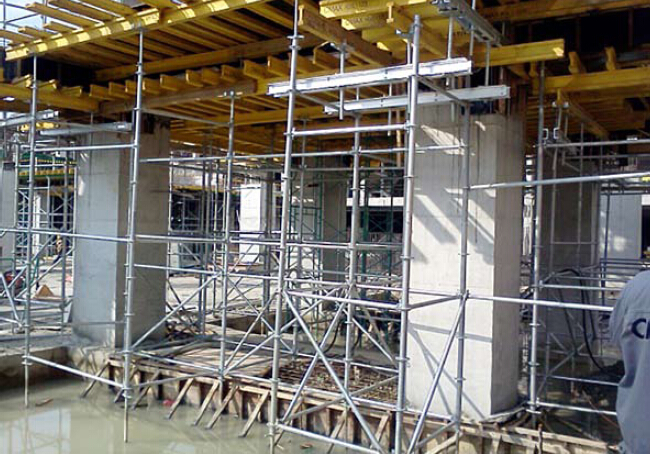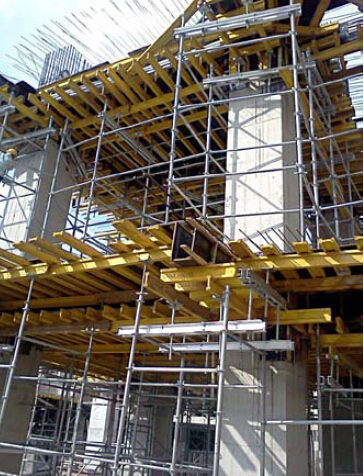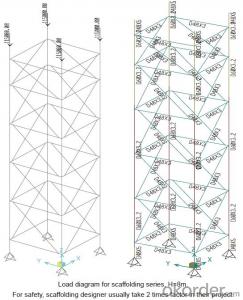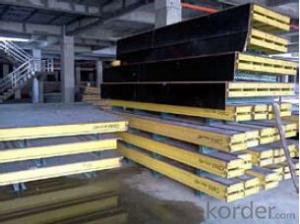Ring-lock scaffolding Accessories for formwork and scaffolding system
- Loading Port:
- Tianjin
- Payment Terms:
- TT OR LC
- Min Order Qty:
- 50 m²
- Supply Capability:
- 1000 m²/month
OKorder Service Pledge
Quality Product, Order Online Tracking, Timely Delivery
OKorder Financial Service
Credit Rating, Credit Services, Credit Purchasing
You Might Also Like
Ring-lock Scaffolding
A support system for construction, ownsadvantages of both cup-lock scaffolding andshoring tower.
It is in the development direction of new typescaffolding.
It is widely used in buildings, bridges, tunnels etc..
Characteristics:
◆ Easy to storage and transportation
◆ High degree of standardization
◆ Easy and quick erection
◆ Excellent stability and bearing capacity


- Q:Can steel formwork be used for pier caps?
- Yes, steel formwork can be used for pier caps. Steel formwork offers several advantages such as high strength, durability, and reusability. It can provide a smooth and precise finish to the pier caps, ensuring a high-quality end result. Additionally, steel formwork can be easily assembled and disassembled, allowing for efficient construction processes. Therefore, steel formwork is a suitable choice for constructing pier caps, as it can provide the necessary support and structural integrity required for this application.
- Q:How does steel formwork handle concrete bleeding and segregation?
- Steel formwork helps to handle concrete bleeding and segregation in several ways. Firstly, the smooth and impermeable surface of steel formwork prevents excessive bleeding of water from the concrete mix. This helps in maintaining the desired water-cement ratio, which is essential for the strength and durability of the concrete. Secondly, steel formwork provides a rigid structure that holds the concrete in place, reducing the chances of segregation. It prevents the coarse aggregates from settling at the bottom, ensuring a uniform distribution of aggregates and cement throughout the concrete. Additionally, steel formwork systems are designed with proper reinforcement and bracing, which further minimizes the risk of concrete segregation during the pouring and curing process. The rigid construction of steel formwork also helps in preventing any movement or displacement of the concrete, which can lead to segregation. Overall, steel formwork is an effective solution for handling concrete bleeding and segregation by providing a stable and impermeable surface, proper reinforcement, and preventing any movement or displacement of the concrete.
- Q:Is steel formwork more expensive than other types of formwork?
- Yes, steel formwork is generally more expensive than other types of formwork. Steel is a durable and strong material, making it a preferred choice for construction projects. However, its higher cost compared to alternatives such as wood or plastic formwork can be attributed to the higher manufacturing and material costs associated with steel.
- Q:Can steel formwork be used for both large and small construction projects?
- Yes, steel formwork can be used for both large and small construction projects. Steel formwork is highly versatile and can be adjusted to fit various project sizes. It offers durability, strength, and stability, making it suitable for both small-scale and large-scale construction projects.
- Q:Are there any specific considerations for using steel formwork in areas with high humidity?
- Indeed, when operating in regions with elevated humidity levels, specific precautions must be taken when employing steel formwork. This is due to the fact that high humidity can prompt an increased absorption of moisture by the steel formwork, ultimately leading to corrosion. In order to counteract this phenomenon, it is imperative to employ steel formwork that has undergone suitable treatment with anti-corrosion coatings or galvanized materials, which serve as a protective barrier against moisture. Furthermore, it is of utmost importance to consistently inspect and maintain the formwork in high humidity areas, as this will enable the identification of any indications of corrosion and facilitate the implementation of appropriate measures to impede its progression. Additionally, it is advisable to ensure adequate ventilation and airflow surrounding the formwork, as this will aid in reducing the humidity levels and minimizing moisture absorption.
- Q:How does steel formwork affect the overall construction project management?
- Steel formwork can have a significant impact on overall construction project management. Here are a few ways it can affect the management of a construction project: 1. Time efficiency: Steel formwork is known for its durability and reusability, which can help save time during construction. With proper planning and coordination, steel formwork can be easily assembled and disassembled, allowing for faster construction progress. This time efficiency can lead to better project scheduling and improved overall project management. 2. Cost-effectiveness: Although steel formwork may have a higher initial cost compared to other formwork materials, its ability to be reused multiple times makes it a cost-effective choice in the long run. As a result, project managers can allocate their budget more efficiently, reducing unnecessary expenses and ensuring the project stays within the allocated cost limits. 3. Quality control: Steel formwork provides a smooth and uniform finish to concrete structures. This allows project managers to maintain high-quality standards throughout the construction process. By using steel formwork, project managers can ensure that the final product meets the required specifications and standards, reducing the need for rework and potential delays. 4. Safety and durability: Steel formwork is known for its strength and stability, making it a safe choice for construction projects. Its robustness helps prevent accidents on-site and provides a secure work environment for construction workers. Additionally, the durability of steel formwork ensures that it can withstand the pressures exerted during the concrete pouring process, reducing the risk of structural failures and subsequent rework. 5. Flexibility and adaptability: Steel formwork offers a high degree of flexibility, allowing project managers to adapt to changes and modifications in the construction plans. Whether it's adjusting the formwork design or reusing the same formwork for different parts of the project, the flexibility of steel formwork enables project managers to respond quickly to unforeseen circumstances, minimizing project disruptions. In conclusion, steel formwork can significantly impact the overall construction project management by improving time efficiency, cost-effectiveness, quality control, safety, and flexibility. Its durability and reusability make it a valuable asset for project managers, enabling them to deliver projects on time, within budget, and to the desired quality standards.
- Q:What are the typical environmental considerations when using steel formwork?
- Several typical environmental considerations need to be addressed when using steel formwork. Firstly, the production of steel requires a substantial amount of energy and natural resources, resulting in environmental degradation and greenhouse gas emissions. To address these impacts, it is crucial to prioritize the use of recycled or reclaimed steel whenever possible. This reduces the demand for new steel production and lessens the environmental footprint associated with the formwork. Another key consideration is the waste generated during construction. Steel formwork produces a significant amount of waste, including offcuts and discarded pieces. Proper waste management practices, such as recycling or reusing these materials, should be implemented to minimize the environmental impact. In addition, the transportation of steel formwork contributes to carbon emissions and air pollution. Optimizing transportation routes and modes, and choosing more sustainable options like rail or water, should be pursued whenever feasible. Furthermore, the use of steel formwork can impact the construction site itself. The installation and removal of the formwork can disturb the natural environment, leading to soil erosion and habitat destruction. Implementing erosion control measures and minimizing the formwork's footprint can help mitigate these impacts. Lastly, the longevity and durability of steel formwork should be considered. With proper maintenance and reuse, steel formwork can have a long lifespan, reducing the need for frequent replacement and ultimately minimizing waste and resource consumption. In conclusion, when using steel formwork, it is essential to consider the entire lifecycle of the material and adopt sustainable practices to minimize its environmental impact. This includes prioritizing recycled steel, implementing proper waste management, optimizing transportation, mitigating site disturbance, and promoting durability and reuse.
- Q:Can steel formwork be used for concrete structures in marine environments?
- Steel formwork can be used for concrete structures in marine environments, but it requires special considerations and precautions. Marine environments, with their high levels of saltwater exposure and corrosive elements, pose unique challenges for steel formwork. The corrosive nature of the seawater can cause rapid deterioration and rusting of the steel formwork, compromising its structural integrity. To mitigate these risks, it is necessary to use high-quality corrosion-resistant steel, such as stainless steel or galvanized steel, for the formwork. These materials have better resistance to corrosion and can withstand the harsh marine environment for a longer period. Additionally, proper maintenance and regular inspection are essential to identify any signs of corrosion or damage and address them promptly. This may involve cleaning the formwork regularly, removing any accumulated salt or debris, and applying protective coatings to prevent corrosion. Furthermore, it is important to consider the design of the formwork to ensure proper drainage and minimize water exposure. Adequate provision for drainage channels and weep holes should be included to avoid the accumulation of water, which can accelerate corrosion. In conclusion, while steel formwork can be used in marine environments, it requires careful selection of corrosion-resistant materials, regular maintenance, and proper design considerations to ensure its durability and longevity. It is recommended to consult with experienced professionals and engineers who have expertise in marine construction to ensure the success of concrete structures in such environments.
- Q:How does steel formwork affect the construction schedule?
- Steel formwork can greatly affect the construction schedule in a positive way. Due to its strength and durability, steel formwork allows for faster and more efficient construction processes. This results in reduced construction time and faster completion of the project. Additionally, steel formwork is reusable, which further saves time and resources as it can be quickly dismantled and used for future construction projects.
- Q:How does steel formwork handle different concrete pumping methods?
- Steel formwork is a versatile and durable solution for handling different concrete pumping methods. It is designed to withstand the pressure and force exerted during the pumping process, making it suitable for various pumping techniques. One common concrete pumping method is the use of boom pumps, which involves a flexible or telescopic boom that extends to reach the desired location. Steel formwork can easily accommodate this method as it provides a stable and secure surface for the boom pump to rest on. The strong and rigid nature of steel ensures that the formwork remains intact and can withstand the weight and vibrations generated by the pumping process. Another popular pumping method is line pumping, which utilizes a series of pipes and hoses to transport concrete to the desired location. Steel formwork is compatible with this method as well, as the pipes and hoses can be easily secured to the formwork using clamps or brackets. The formwork acts as a support system for the pipes, ensuring that they remain in place and can effectively transport the concrete without any disruptions. Additionally, steel formwork can handle other concrete pumping methods such as trailer-mounted pumps or truck-mounted pumps. These methods involve the use of a portable pump that can be moved to different locations. Steel formwork can be easily repositioned or adjusted to accommodate the pump, providing a stable and reliable platform for the pumping process. Overall, steel formwork is a suitable choice for handling different concrete pumping methods due to its strength, stability, and adaptability. It can effectively support the equipment used in various pumping techniques, ensuring a smooth and efficient concrete placement process.
1. Manufacturer Overview |
|
|---|---|
| Location | |
| Year Established | |
| Annual Output Value | |
| Main Markets | |
| Company Certifications | |
2. Manufacturer Certificates |
|
|---|---|
| a) Certification Name | |
| Range | |
| Reference | |
| Validity Period | |
3. Manufacturer Capability |
|
|---|---|
| a)Trade Capacity | |
| Nearest Port | |
| Export Percentage | |
| No.of Employees in Trade Department | |
| Language Spoken: | |
| b)Factory Information | |
| Factory Size: | |
| No. of Production Lines | |
| Contract Manufacturing | |
| Product Price Range | |
Send your message to us
Ring-lock scaffolding Accessories for formwork and scaffolding system
- Loading Port:
- Tianjin
- Payment Terms:
- TT OR LC
- Min Order Qty:
- 50 m²
- Supply Capability:
- 1000 m²/month
OKorder Service Pledge
Quality Product, Order Online Tracking, Timely Delivery
OKorder Financial Service
Credit Rating, Credit Services, Credit Purchasing
Similar products
New products
Hot products
Hot Searches
Related keywords

























